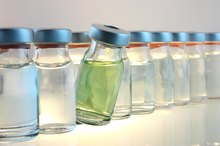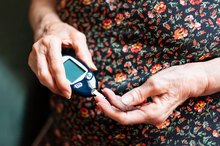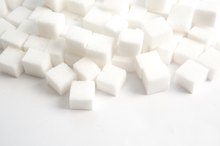The Effect of Benedict Solution on Glucose
A quick way to test for the presence of glucose in a sample is to add Benedict Solution, a copper-containing reagent. Benedict Solution is a solution that is light blue in color when unreacted but, when added to glucose and heated, turns brownish-orange. Benedict Solution can also detect the presence of other structurally similar sugars.
What is Glucose?
Glucose is a simple carbohydrate, and it is the most basic energy unit for plants and animals. Structurally, glucose is a six-carbon sugar which has an aldehyde on the end in its linear (acyclic) form.
All food that we eat eventually gets converted, or synthesized, through a series of metabolic reactions, into glucose, which is used or stored for energy. Plants harness the energy of the sun and synthesize glucose through the process of photosynthesis.
- Glucose is a simple carbohydrate, and it is the most basic energy unit for plants and animals.
- All food that we eat eventually gets converted, or synthesized, through a series of metabolic reactions, into glucose, which is used or stored for energy.
How Benedict Works
What is a Standard Glucose Solution?
Learn More
Benedict Solution is light blue because it contains copper sulfate. When it is mixed and heated with a sugar, such as:
- glucose
- which has electrons available to donate
- the copper will accept the electrons
- become reduced
- which turns it brownish-orange
During this process, the blue copper (II) ion is reduced to a red copper (I) ion. While the copper is being reduced, the glucose gives up an electron and is oxidized. Because glucose is able to reduce the copper in Benedict Solution, we call it a reducing sugar.
- Benedict Solution is light blue because it contains copper sulfate.
- When it is mixed and heated with a sugar, such as: * glucose
* which has electrons available to donate
* the copper will accept the electrons
* become reduced
* which turns it brownish-orange During this process, the blue copper (II) ion is reduced to a red copper (I) ion.
Reducing Sugars
Glucose is not the only reducing sugar. Any sugar that is structurally capable of donating electrons to Benedict Solution (or a similar reagent) falls into this category. Aldehyde-based sugars that are in their linear, acyclic form are able to donate electrons and reduce other molecules. Some sugars are "locked" into their cyclic form and structurally unable to open into their linear form. These are most commonly nonreducing sugars 1. Other examples of reducing sugars include ribose and sucrose.
- Glucose is not the only reducing sugar.
- Aldehyde-based sugars that are in their linear, acyclic form are able to donate electrons and reduce other molecules.
Method
How to Test Foods for Sugars
Learn More
The Benedict test is fast and gives consistent results. Fill a test tube with a few mL of your test solution and add an equal amount of Benedict's Solution. After briefly mixing and heating the tube a few minutes at 95 degrees C, you should see results. The Benedict test is quantitative, as well, so that the amount of brownish-orange precipitate formed is proportional to the amount of reducing sugar you had in your test tube. Don't be disturbed if your tube turns a muddy green. Your initial glucose concentration was likely so low that only some of the blue copper (II) ions reacted.
- The Benedict test is fast and gives consistent results.
- The Benedict test is quantitative, as well, so that the amount of brownish-orange precipitate formed is proportional to the amount of reducing sugar you had in your test tube.
Uses
The most common use for Benedict Solution is the detection of glucose in urine for the diagnosis of diabetes. Diabetics excrete glucose into their urine because they are unable to properly absorb it into their cells. After a positive diagnosis, additional tests are needed to quantify the amount of glucose excreted.
Related Articles
References
Writer Bio
Brooke Yool just started writing in 2009 and has been writing for various websites since 2010. Yool is a Seattle-based certified Pilates and group fitness instructor. She is passionate about sharing her knowledge to improve the health of others. She holds a Master of Science in pharmaceutical chemistry from University of California, San Francisco.









